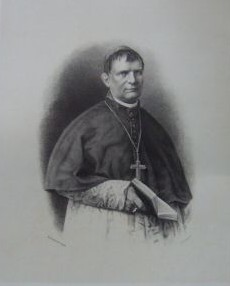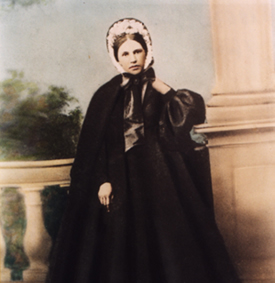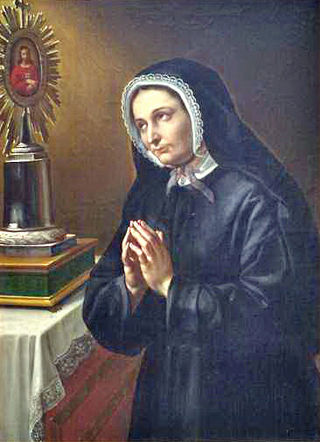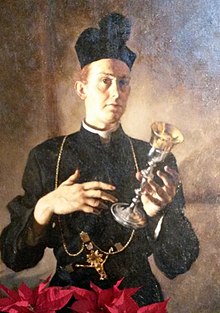
The Missionaries of the Precious Blood is a Catholic community of priests and brothers. The society was founded by Saint Gaspar del Bufalo in 1815.

Maria Matilda De Mattias was an Italian woman who founded the religious congregation of the Sisters Adorers of the Blood of Christ. She is a saint in the Catholic Church, having been canonized by Pope John Paul II in 2003.

Gaspar Melchior Balthazar del Bufalo, CPPS, also known as Gaspare del Bufalo, was a Catholic priest and the founder of the Missionaries of the Precious Blood. Canonised as a saint in 1954, he is liturgically commemorated on October 21.

Lodovico Altieri was an Italian Roman Catholic cardinal. He served in various capacities under various popes and belonged to a noble Roman house making him a descendant of Pope Clement X.

Sisto Riario Sforza was an Italian Roman Catholic cardinal who served as the Archbishop of Naples from 1845 until his death. Sforza's rapid rise through the Church ranks began with various appointments before he served as the Bishop of Aversa for seven months. He was promoted to the Naples archdiocese and cardinalate. After two months, Sisto became a close supporter of Pope Pius IX and a vocal participant in the First Vatican Council.

Maria Franciszka Siedliska, also known by her religious name Maria of Jesus the Good Shepherd, was a Polish Roman Catholic professed religious and the founder of the Sisters of the Holy Family of Nazareth. In childhood Siedliska was indifferent to her faith but after a local priest had converted her she became aware of a call to the religious life which her parents opposed. However the death of her father in 1870 enabled her to pursue her vocation. In 1873 she decided to found a religious congregation that received the blessing of Pope Pius IX before being established during Advent in 1875. Siedliska expanded her congregation from Rome to her native Poland and elsewhere, including Great Britain, France and the USA where she visited during her extensive travels.
The Archconfraternity of the Most Precious Blood was founded by Francesco Albertini, canon of the Basilica di San Nicola in Carcere, Rome, in 1808.

The Feast of the Most Precious Blood of Our Lord Jesus Christ is a feast, which was in the General Roman Calendar from 1849 to 1969. It is focused on the Blood of Christ and its salvific nature.

Franz Josef Rudigier was an Austrian Roman Catholic prelate and served as the Bishop of Linz from his appointment in 1853 until his death. Much of his local diocese grew due to his vigorous in promoting evangelic zeal and fundamental religious principles. He became the intellectual figurehead for Catholics in their struggle with liberalism. He promoted the Christian press and took a visible stand defending the 1855 concordat, when liberals annulled it without papal consultation in 1870. A beatification process for Rudigier was initiated under Pope Pius X in 1905 and he was titled as a Servant of God. The confirmation of his life of heroic virtue allowed for Pope Benedict XVI to name him as Venerable in 2009.

Elisabetta Canori Mora was an Italian member of the Third Order of the Most Holy Trinity. Mora married an abrasive husband who remained unfaithful and abusive to her but at the time of her death secured his repentance, and he became a priest. Mora had a range of spiritual experiences in which she heard the voice of God and visions of the Madonna and other saints while also experiencing religious ecstasies during her life.

Luigi Maria Monti was an Italian Roman Catholic professed religious and the founder of the Sons of the Immaculate Conception. He was referred to as "Father" despite not being an ordained priest. Monti served as a nurse for most of his life and aided the ill in the Santo Spirito hospital in Rome while he was there and also worked to tend to ill people during the Brescia cholera epidemic in 1855. Monti also considered entering the religious life and joined the order of Lodovico Pavoni for a brief period of time though became a religious of his own order later on.

Giuseppe Benedetto Dusmet – born Giuseppe Dusmet – was an Italian Roman Catholic cardinal who served as the Archbishop of Catania from 1867 until his death. He became professed into the Order of Saint Benedict where he took "Benedetto" as his religious name. He studied under the Benedictines prior to joining them before serving as a professor in addition to prior and abbot. His elevation to the episcopate saw him distinguish himself in cholera epidemics when he tended to the ill while also remaining a strong advocate for the poor of his archdiocese. He remained a Benedictine and was known to continue to don the Benedictine habit instead of the red cardinal's regalia.

Leopoldo da Gaiche, born Giovanni Croci, was an Italian Roman Catholic priest and a professed member of the Order of Friars Minor who became well known for wearing a crown of thorns. He was a preacher who went from diocese to diocese and served in a position of power in the Franciscan order in the Umbrian region in which he pushed for strong adherence to the Rule of Saint Francis of Assisi. He has been called the "Apostle of Umbria".
Caterina Cittadini was an Italian Roman Catholic religious from Bergamo who established the Ursuline Sisters of Saint Jerome Emiliani. The order was dedicated to the education of girls in Bergamo and in the surrounding areas and has since expanded outside of the Italian nation. Cittadini was orphaned as a child and cultivated her faith among fellow children in an orphanage where the spiritual direction was strong. Her order came in part of her devotion to Saint Jerome Emiliani as well as the Blessed Mother.

Caterina Sordini was an Italian Roman Catholic professed religious that established the Sisters of Perpetual Adoration, in latin Adoratrices Perpetuae Sanctissimi Sacramenti, devoted to the Eucharist. She assumed the religious name of "Maria Maddalena of the Incarnation" when she became a member of the Third Order of Saint Francis during her adolescence.
Francesco Spinelli was an Italian Roman Catholic priest and the founder of the Sisters Adorers of the Blessed Sacrament. Spinelli became close contemporaries of Geltrude Comensoli and Luigi Maria Palazzolo and had a previous collaboration with Comensoli in which the two established a religious institute in Bergamo before a rift between members caused Spinelli to distance himself from its work and leave.

Pietro Bonilli was an Italian Roman Catholic priest and the founder of the Sisters of the Holy Family of Spoleto. Bonilli served as a diocesan priest for his entire life in both Trevi and Spoleto while using his order to reach out to orphans and homeless people.

Louis-Antoine-Rose Ormières Lacase was a French Roman Catholic priest from the Diocese of Carcassonne and the founder of the Sisters of the Guardian Angel - an order dedicated to the care of children and the educational needs of the poor.

Alphonse-Marie Eppinger, SDR; 9 September 1814 – 31 July 1867), born Elisabeth Eppinger, was a French Catholic nun and the founder of the Sisters of the Divine Redeemer.

Giovanni Battista Quilici was an Italian Roman Catholic priest and the founder of the Daughters of the Crucified as well as several other religious institutions. The priest originated from Livorno where he served as a parish priest for several decades in addition to his role as a caregiver for prostitutes and ill people – he distinguished himself during an 1835 cholera epidemic that claimed his sister. He had the esteem of other noted individuals including Grand Duke Leopoldo II and Juliette Colbert.















